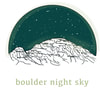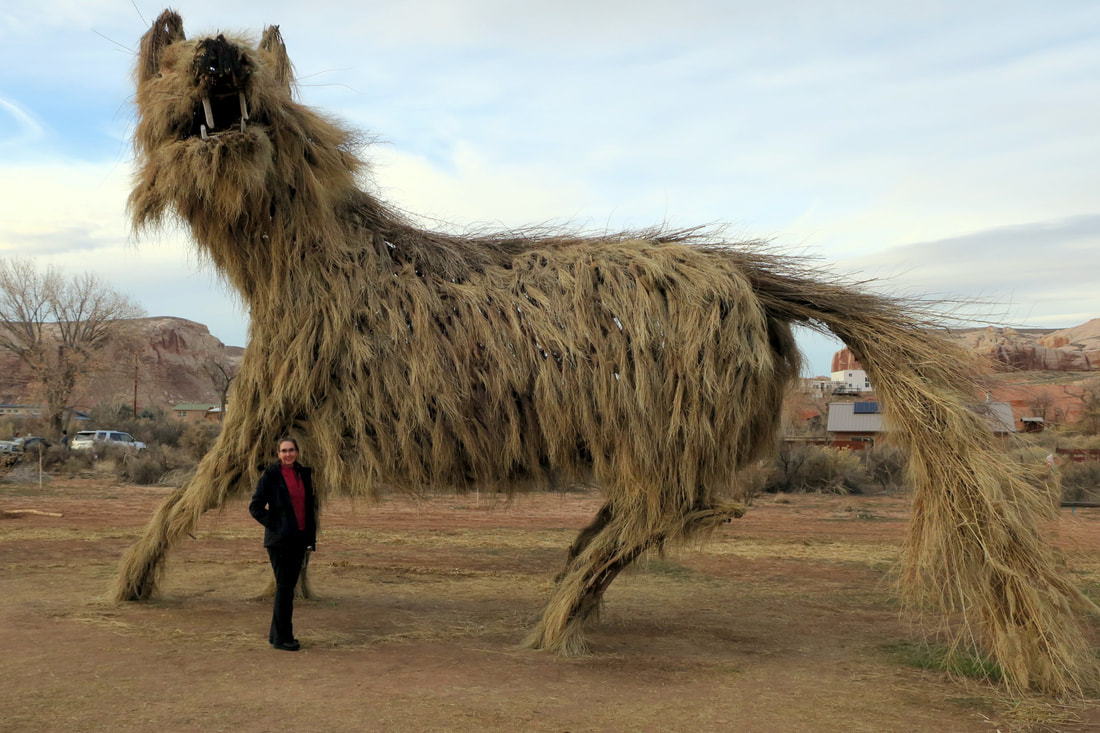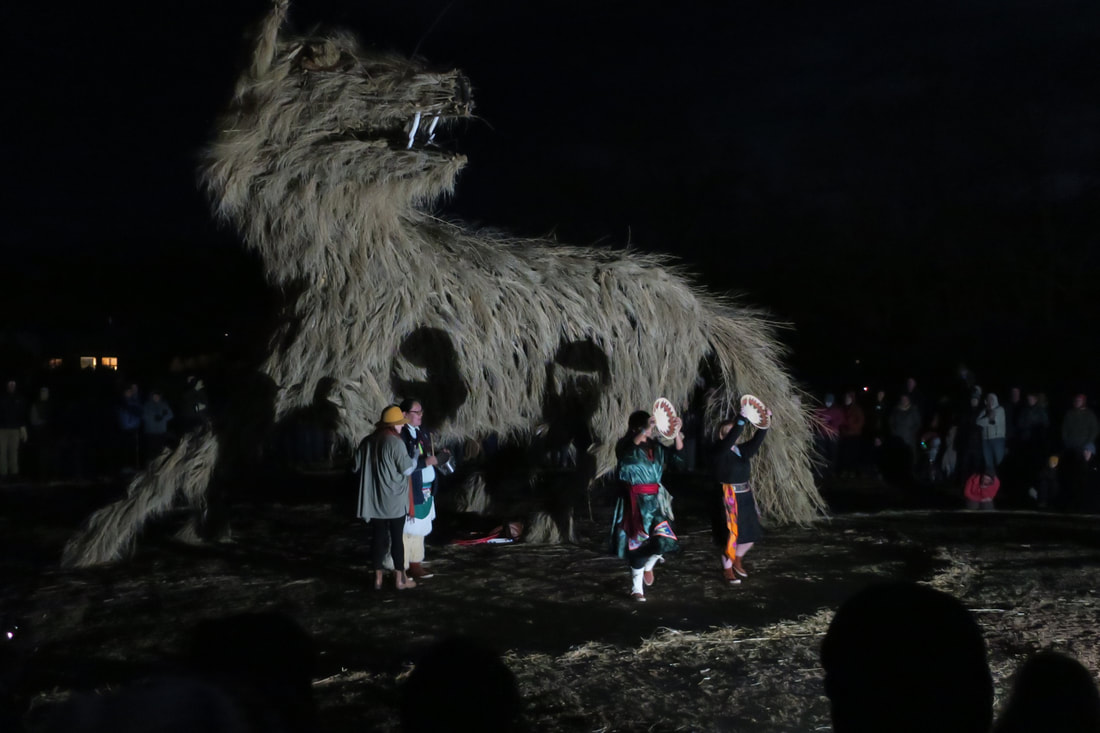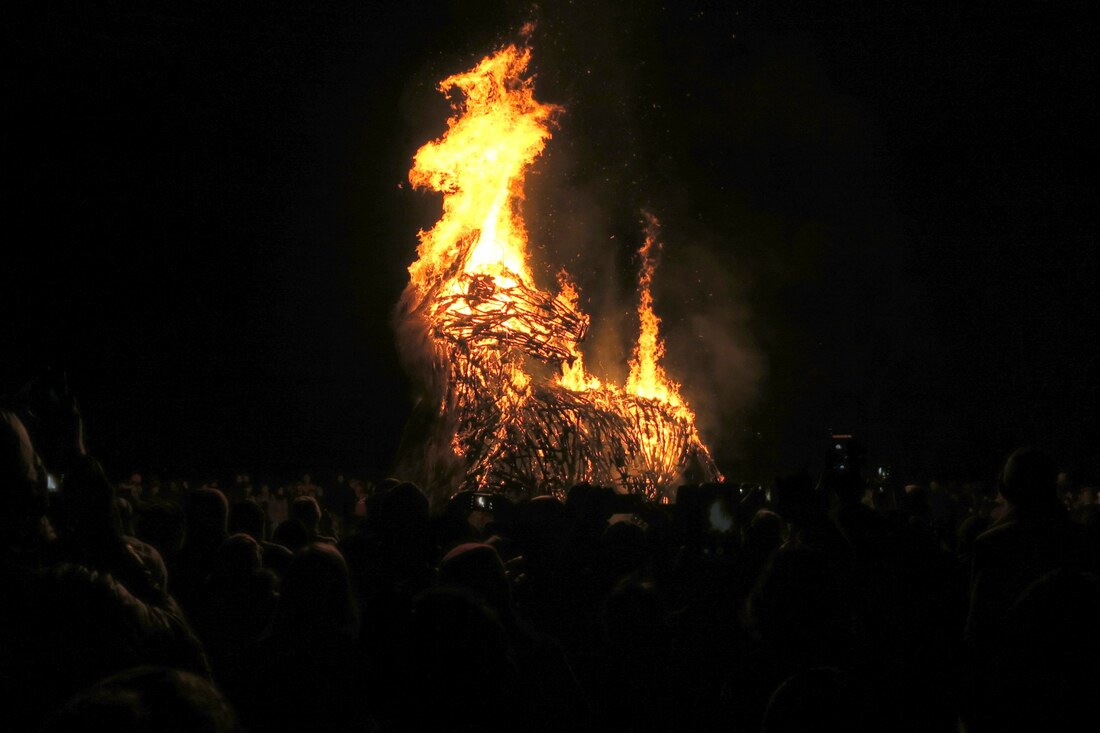|
On the longest night of the year, under a full super-moon, a ritual evolves in a small Utah town. Mark Bailey, thotsandshots.net A full super-moon rose as complete dark enveloped a crowd gathered in the December cold around campfires and torches to celebrate the longest night of the year with art, culture, and sculptural pyrotechnics. For those like me who are not motivated by the Christian religious myth of Christmas, Winter Solstice is the natural time to celebrate the turn of the seasons. A ritual is called for and one is evolving in rural Bluff, Utah, with all the resulting tensions that come with change and growth. Bluff is a newly incorporated town of some 320 souls in San Juan County in the far southeast corner of Utah. Like Torrey, it is an oasis of progressiveness in a desert of right-wing politics. Bluff supports Bears Ears National Monument and has launched a popular new education center to promote visiting Bears Ears with respect while the political system sorts out the restoration of the monument. Belligerent San Juan County commissioners (see Malicious Prosecution in San Juan County) were the primary antagonists to the formation of the monument. They infamously celebrated with Trump by getting their white cowboy hats signed by the nakedly racist president at the Republican monument destruction proclamation ceremony in Salt Lake City in December 2017. Native Americans were the primary advocates for the history making monument. 30 Tribes have formally declared their support for the Bears Ears Inter-Tribal Coalition‘s effort to protect the Bears Ears landscape for all future generations. Half of San Juan County is Native American. For seven years now, artist Joe Pachak has been creating sculptures made of local branches and brush to ceremonially burn on Winter Solstice. Upcoming Torrey House Press author Zak Podmore tells how Joe did not start out with a Native American theme. In 2011 he built his first sculpture to burn in honor of an elk he’d bow hunted that year. The next year he built a mammoth. The sculptures got bigger and so did the crowds. In 2017 he built a 40 foot tower of two dancing bears in a connection to the Ute bear dance ritual. This year music and dance were performed by Navajo groups and Navajo medicine man Curtis Yanito was invited to offer a prayer. My guess is that around 300 people were gathered for the burn, a majority of them white and many, like Kirsten and me, from out of town. It was dark, and chilly, but I did not see many white cowboy hats. My sense, again a guess, is that most of those in attendance were supporters of the Bears Ears National Monument. The monument is to protect the natural landscape and its myriad cultural resources. The land is so resplendent with ancient Native American artifacts that it should have been the first national monument and not, 110 years later, the latest. At a celebration of land and culture it makes sense to invite Native Americans to share their culture. But the crowd and Yanito had different expectations for the evening’s program and not all Native Americans were comfortable with appropriation of their culture as entertainment for the evolving ceremony. Max Oelschlaeger in his magnificent work, The Idea of Wilderness, expresses his hope that a new creation story will develop in way that rings true in the postmodern age which necessarily has, ” . . . both scientific plausibility and religious distinctiveness.” I have been besotted with the notion since I first read it at my son’s suggestion a dozen or so years ago. I founded Torrey House Press based on the same hope. A solstice ceremony is primed to have both scientific plausibility and religious distinctiveness. It is not the celebration of an implausible virgin birth, but rather of the shortest day of the year caused by the earth’s axial tilt. It is a celebration of the dark, of the assurance of a return of the light, of waiting and of receiving, of reflection and of promise. The Native American creation narratives of human-kind emerging from the earth is much closer to the scientific story of our evolving from it. In both, creation is the creator and in neither are we created separately from the earth. Yet science cannot explain how life came about, nor what our consciousness is or how it came about, and a sense of awe is called for of the unlikelihood of it all. If you believe we were created by the Earth then you have a sense of natural source and connection. If you believe you were placed here by a super-natural being, a something or someone that is beyond nature, and ordered to fill and subdue the Earth, then you have a sense of a disconnected relationship. From this divide comes conservationists like me who think we need to revere and protect that which created us, and extractors, like the San Juan County commissioners who think they will get their end reward only after they have logged, mined, drilled, drained and grazed every last fragment of creation. In Bluff at Solstice this year there were a couple of metaphorical crossroads. One was the diagonally opposed desires of conservationists, both Native American and non-native, in favor of Bears Ears National Monument, and the desires of the extractors opposed to the monument. Then there was the more nearly parallel crossroads of the Native American traditions and of non-natives in search of ritual who both revere and respect the land and celebrate the natural seasons. Of the more nearly parallel paths this year, the medicine man Yanito and at least some of the crowd seemed to have differing expectations for the burn ceremony. Last year for the first time a short Native prayer was offered and translated. This year the dancing performance and the story of Coyote went on for much longer. Navajos may have a different sense of time than the impatient, and chilled, visiting non-native crowd. Perhaps a Navajo origin story should not be abridged yet many were there only for the spectacle of the burn. It is likely that both Pachak and Yanito were at least somewhat offended by the crowd’s rowdy impatience. Later, on social media, there was reticence expressed by Native Americans about incorporating their sacred traditions as performance in the context of a secular burning ceremony. The burn is a non-native’s idea and how to blend in Native tradition appropriately has yet to be fully determined. It is a creative and spiritual tension from which something original will evolve. Where there is creative tension there are creators. Artists, poets, sculptors, and writers were all there. Kirsten mingled with writers in search of future words from the land. She will be there again. I may drop her off and observe from a quieter, more solitary vantage point. I like to listen in the dark silence for the music of the spheres. But I am eager to see how this ceremony with both scientific plausibility and a religious distinctiveness evolves. Under a coincident full super-moon, on the longest night of the year, how could something new not emerge?
0 Comments
|
“The cosmos is within us. We are made of star-stuff. We are a way for the universe to know itself.” archives
January 2020
categories |




 RSS Feed
RSS Feed
